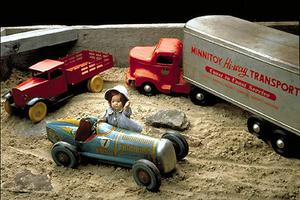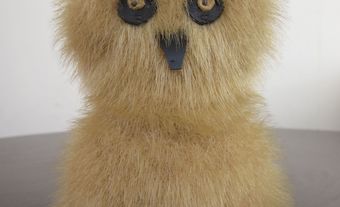
Toys and Games
Toys and Games In the 19th century, Canadians shared current Victorian ideas on child-raising, which saw children as a special group needing play and recreation, along with a firm and religious upbringing. This view coincided with the introduction of mass-production methods. Toy manufacturers in England, France, Germany and, after 1850, the US, supplied their own markets and also exported to Canada. Between 1860 and 1915 some 20 Canadian manufacturers also made toys for Canadian children.Canadian toys were made almost entirely of wood, a plentiful and cheap material. Then, as now, part of play was preparation for the adult world, and toys reflected that world in miniature. Toy furniture, vehicles and horses were the basic wooden toys made by early manufacturers. In addition, cabinetmakers might, on special order, make toy tables, chairs, beds, cradles, chests of drawers, dish cupboards and sideboards. In the 1860s, makers of chairs, carriages, wagons and sleighs began to advertise child-sized versions of their products; some also offered toys. From 1880 to 1890 the C.T. Brandon Co, Toronto, included Indian clubs, toy wagons, carts and washboards in their list of WOODENWARES. In 1890, the Gendron manufacturing Co, Toronto, one of the longest-lived Canadian toy producers (1890-1970s), began making children's carriages, wooden toys, carts and wheelbarrows. Children's carriages followed the latest fashion, as did toy carriages. By the 1890s they were produced in rattan as well as wood. Two potteries advertised toys. In 1851 James Bailey, Bowmanville, Ont, offered molded toys. By the 1880s, the St Johns Stone Chinaware Co, St-Jean, Qué, made doll sets in blue or white clay.
In this early period, only 2 craftsmen made toys as their sole product. In 1876 Édouard Alfred Martineau, Montréal, began making wooden toys; he continued until 1914, supplementing his toymaking with a retail business. By 1881, Mositz Lindner, Berlin [Kitchener], Ont, was making rocking horses and toys. Cosgrove and Co (1890-91) and the Berlin Novelty Works (1899), both in Berlin, made hobby or rocking horses, perhaps as a sideline. These toymakers probably also made other popular horse toys, eg, stationary-platform rocking horses, small horse-on-platform pull toys, and, for very young children, the shoofly, 2 boards cut in the shape of a horse, mounted on rockers and joined by a flat seat.
GAMES played in the late 19th century included CHESS, checkers, cribbage, backgammon, dominoes, Parcheesi and dissected maps and pictures (jigsaw puzzles). In Québec, where checkers were particularly popular, many boards were homemade. Croquet, an American fad of the 1860s, was much played in Canada. In 1871, 2 Toronto woodturning firms, Hastings and Peterkin, and Leslie and Garden, made croquet sets for the lawn or parlour.
Although many toys were available, it is unlikely that any one child would have had many toys. For some children economic necessity meant that play was a rare luxury. Farm children were expected to help with lighter chores and, until 1880 when provincial legislation began to prevent it, children as young as 10 were allowed to work 9-hour days in some city factories. For them, toys would be improvised or homemade from available materials.
WWI curtailed German and English toy production and spurred the Canadian industry. Crokinole boards, toy battleships and building blocks were added to the staple wooden toys. Between 1915 and 1920, 80 individuals or companies made toys: some lasted only one year; others failed as a result of renewed postwar competition. A wider range of companies making more general lines of wares also made toy lines, using brass, tin, iron, lead and rubber. Some, like the Dominion Toy Manufacturing Co, Toronto (1911-34), made dolls and stuffed animals. A flourishing cottage industry produced many varieties of rag doll. Some firms, like the Toy Soldier Novelty Co, Kitchener, Ont, and the Beaver Toy Manufacturing Co, Toronto, made toy soldiers; the Incandescent Light Co, Toronto, made toy bugles and trumpets. The Consolidated Rubber Co, Toronto, made rubber balls, hockey pucks, rattles and animals. The Ideal Bedding Co, Toronto, made a line of toy brass furniture. Thomas Davidson Manufacturing Co, Montréal, made enamelware dishes and toy trunks. The Macdonald Manufacturing Co, Toronto, which made a line of decorated tinware from 1917 to 1942, also made tin toy pails, shovels, cups, plates and banks. The Coleman Fare Box Co, Toronto, made banks; the Belleville Hardware and Lock Manufacturing Co made cast-iron toys. In Toronto, the Manual Construction Co and Reliance Toy Co made steel construction sets. Canadian Toys Ltd, Hamilton, Ont, from 1920 to 1929, made metal humming and dancing tops, and steel construction toys.
However, the Canadian toy industry was not a large one. By 1928 only 10 firms specialized in toy production. The industry, concentrated in Ontario and Québec, employed 129 people. Value of toys made (excluding toy vehicles and dolls) was $465 424 ($320 986 for wooden toys). Toy vehicle production was worth $394 754; doll production, $281 393.
In the 1940s PLASTIC was introduced for rattles and later for beach toys, tractors, wagons, trucks and construction sets. Cheerio Toys and Games, Toronto, made plastic miniature furniture and gym sets. Aluminum and fibreglass were used to make flying saucers. Toy sets for all purposes made their appearance: tools (garden, carpenter, mechanic), archery, printing, construction and road racing sets, embroidery, sewing, tea, coffee and cooking sets, brushes and cleaning sets, ironing boards and irons, table and chair sets. By 1942, 17 firms (4 in Montréal, 13 in Toronto), employing 604 people, were exclusively devoted to toy making. In 1960, although 126 firms were making toys in Canada, only about 20 specialized in toy making. In the 1960s and 1970s several multinational firms began making toys in Canada (Louis Marx, Mattel, Tonka, Coleco). In 1987 there were 85 firms in the industry. In 1986 retail sales amounted to $1.2 billion, of which $372 million was from imports. In that same year, Canada exported $56 million. While the industry remained concentrated in central Canada - over one-third of the production is in Ontario and one-quarter in Québec - the period from 1970 to the 1980s saw the renewal of a CRAFT industry, in NB, PEI and BC, making perennial favourites in wood.

 Share on Facebook
Share on Facebook Share on X
Share on X Share by Email
Share by Email Share on Google Classroom
Share on Google Classroom


